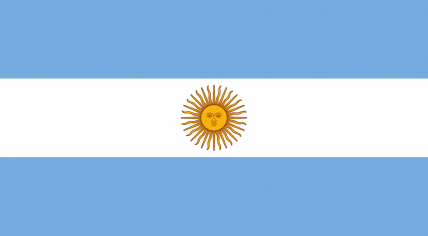| Category: Democratic Socialists | ||
| Civil Rights: Good |
Economy: Frightening |
Political Freedoms: Some |
Regional Influence: Truckler
Location: Geopolity
3
Nation Application
Nation ApplicationNS Account Name/Nation Name: Republica-Argentina (NS). Argentina (short form - RP). Argentine Republic (formal name - RP).
Head of State: President Guillermo Bermejo
Head of Government: President Guillermo Bermejo
Claims: RL Argentina, Uruguay, Falkland Islands
Capital City: Buenos Aires
Preferred Map Color: (Optionally, include hex code)
Demonym: Argentine
Population: 49,128,378 (original). 50,886,322 (updated, May 2022).
GDP (Nominal): 518,282,280,000
Description of Economy: Free Market Economy, few key sectors overseen by Government institutions.
Major exports: Soybeans and derivatives, petroleum and gas, vehicles, corn, wheat.
Major imports: Machinery, motor vehicles, petroleum and natural gas, organic chemicals, plastics.
Main industries: Food processing and beverages, motor vehicles and auto parts, appliances and electronics, machinery and equipment, chemicals, pharmaceuticals, glass, steel and aluminum, cement, textiles, tobacco products, publishing, furniture, leather, etc.
Description of Government: Federal Presidential Republic.
Presidential elections every 5 years. Parliamentary elections once a presidential term has reached 2.5 years.
Democratic systems are strong and enjoy public support, although there are instances of corruption in less populated provinces, which are maintained by local governors for their own political wellbeing.
Description of Military:
Total active personnel: 195,000. (128k - Army. 40k - Navy. 27k - Air Force.)
Reserve personnel: 200,000.
Equipment nationality: Mostly Late Cold War, Modern Soviet/Russian equipment, Chinese modern equipment.
History: Argentina declared its independence from Labyrnna on July 9, 1816.
Having been abandoned by French, Spanish and British settlers, the United Provinces of the Rio de la Plata took formal possesion of the Islas Malvinas (Falklands) on November 6, 1820.
Following a declaration of war, conflict erupted with the Empire of Brazil on December 10, 1825. After nearly 3 years of war, the Provincia Oriental (Cisplatina as it was known in Brazil) was incorporated into the United Provinces of the Rio de la Plata.
Internal political turmoil erupted into a series of interprovincial conflicts and civil wars that cemented the country's status as a federal republic. Although Argentina would continue to be ruled autocratically from Buenos Aires, dissent would be suppressed, and elections would be rigged in favor of the wealthy conservative elites.
The War of the Alliance began on 1864 with the Paraguayan invasion of Misiones. A secret treaty made with Brazil provided for mutual defense in case of Paraguayan aggression. War was declared and after 4 years of conflict, Asunción fell to the allied armies, Paraguay was disarmed, renounced all claims to Argentine and Brazilian territories while relinquishing control of the nowadays Formosa Province.
Expansion towards Patagonia also began during these years, culminating with the Conquest of the Desert in the 1880s. A final border treaty was concluded with Chile in 1881, which divided Patagonia between the two countries.
Migratory waves, especially from Italy and Spain would arrive in the country over the course of the 19th century and the beginning of the 20th century.
Influenced by European socialist and anarchist ideals brought by the immigrants, civil uprisings took place in 1890 and 1905, demanding greater political freedoms. Political fraud continued until 1912, with the enactment of the Sáenz Peña law, which guaranteed mandatory, universal (males aged 18-65) and secret votes. Democracy had gained a firm foothold in Argentina.
The Government remained neutral during WWI, providing mostly food shipments to Great Britain.
The first left-leaning government was elected in 1916, as President Hipólito Yrigoyen won the first free elections in the country. Yrigoyen presided over a rise in the standard of living of Argentina's working class together with the passage of a number of progressive social reforms, including improvements in factory conditions, regulation of working hours, compulsory pensions, and the introduction of a universally accessible public education system. These measures turned Yrigoyen into an extremely popular political figure, and he was reelected in 1921.
Yrigoyen's party, the Radical Civic Union, along with the nascent Socialist and Communist parties formed the People's Patriotic Front which would dominate the political landscape, colliding strongly with more conservative sectors of the country and even defeating a military insurrection in 1930.
As WWII broke out in Europe, Argentina proclaimed its neutrality once again. When the Soviet Union was invaded in 1941, the People's Patriotic Front organized nationwide events with the aim of donating supplies to the USSR. Further assistance consisted of food and medical supplies shipments, but stopped short of declaring war. The declarations against Germany and Japan would be issued on April 1, 1945, a mere month before the end of hostilities in Europe.
Women gained the rights to vote and run for political positions on 1945.
Relations with commercial partners such as the US and Great Britain became strained, while Brazilian authorities remained suspicious of Argentina's growing ties with the Soviet Union. Arms restrictions were imposed in the 50s, as Argentina was deemed to be an antagonist to Western security interests. As such, Argentina had to rely increasingly on Soviet military hardware.
A number of economic crises prompted by foreign speculative bubbles or lower commodities prices during the 80s and 90s affected Argentina. Government enacted stronger regulations to minimize the fallout to society.
Nuclear research started in the 1960s and gained much needed government support around the 1980s with the purpose of achieving energetic independence. Currently 3 nuclear power plants (Atucha I, II and Embalse) operate in the country, accounting only for 10% of Argentina's total energy generation.
Other Notes: (Any other notes with relation to your nation. May be left blank).











